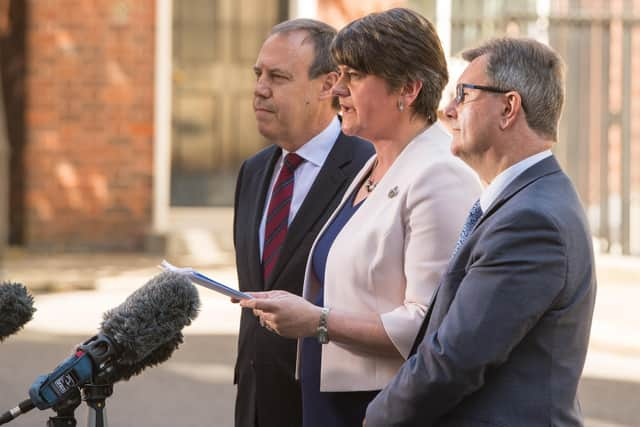Alex Kane: Unionism suffers by not knowing its own narrative


This is the opening section of a piece by Gerry Adams in the April 1999 special edition of the Fordham International Law Journal (an analysis of the NI Peace Agreement with essays from key players): ‘Our peace strategy is the dynamic that led to the Irish peace initiative and then to the IRA ceasefire in August 1994. It is the dynamic that transformed the political focus of all the players and opened the possibility for an end to the centuries old conflict in our country.
‘The basic tenets of this strategy, which we mapped out over a decade ago, are the following: to seek to engage politically our political opponents; to bring about the exercise of the right to national self-determination by the Irish people as a whole; to establish a peace process to bring this about; and to win international support for these positions.’
Advertisement
Hide AdAdvertisement
Hide AdNo mention that the 1994 ceasefire ended in February 1996 with a massive bomb at Canary Wharf. No mention that the ‘peace strategy’ was, for long periods, accompanied by the IRA’s terror campaign. No mention that John Hume and the SDLP had been reaching out to and engaging with political opponents since the early 1970s; as well as winning international support, particularly in America and the EU.


No mention that successive UK governments had, since Stormont’s prorogation in March 1972 (the end of unionist one-party rule), been responsible for huge political/societal/institutional/economic change in NI and the introduction of mandatory power-sharing and the ‘Irish dimension’.
The Fordham essay is just one from hundreds of examples of how Sinn Fein’s key players have presented and shaped ‘their’ narrative. And there is, of course, nothing new about this sort of taking-possession-of-the-story-and-the-agenda approach to the past, present and future.
Yet irrespective of how significant or peripheral their contribution to a move has been (and let’s never forget the GFA owed far more to Hume and Trimble than to Adams and McGuinness) Sinn Fein is remarkably good at marketing the vital importance of their role, while highlighting the continuing need for their imprimatur. And if that means walking all over the SDLP and downplaying its legacy, then so be it. If it means allowing the IRA Army Council to remain in an ‘overarching’ role, then so be it.
Advertisement
Hide AdAdvertisement
Hide AdBut what about the unionist narrative in all of this? Well, that’s a much more complicated matter, because there isn’t something which can easily be identified as an agreed, unifying narrative. From the mid-1960s onwards unionism has found itself divided on how it should respond to issues like civil rights, prorogation, power-sharing, negotiations, compromises and restoring devolution. So much of its time has been consumed by internecine and serial squabbling it has never really got to grips with priorities and end goals.
Put bluntly, unionism doesn’t actually know its own narrative: so how does it write it and present it? How does it counter and deconstruct the narrative of others (not all of which are false, by the way)? The best response to those who you accuse of rewriting history for their own narrative is not just to whinge: you have to deconstruct it properly with hard evidence, as well as setting out your own narrative and history.
What about the British narrative? One of the most common complaints from unionism is the supposed willingness of successive British governments to “listen to nationalists and republicans rather than voices from the pro-Union community”. Why is that, I wonder? Or, putting it another way, why do most unionists believe Wilson, Heath, Callaghan, Thatcher, Major, Blair, Brown, Cameron, May and Johnson didn’t and don’t care about them? Is it true they don’t care? Is it the unwritten policy of successive governments?
A few years ago I had a long conversation with a retired RUC officer. He had a brutally simple question for me, which I’ll paraphrase: ‘The IRA spent decades trying to wreck Northern Ireland. They killed police, army, civilians, bystanders, children, politicians and, when necessary, some of their own. They took their war to the mainland. They attacked PMs in Brighton and Downing Street. All the while Sinn Fein defended and justified them. And yet Sinn Fein/IRA are now allowed to promote themselves as peacemakers and far too many people see them as the good guys of the peace process. Why?’
Advertisement
Hide AdAdvertisement
Hide AdAs I noted earlier, it’s all about SF’s relentless determination to take possession of the narrative and agenda. But there’s more to it than that: namely, successive British governments really do seem determined to buy into key parts of that narrative and, consequently, to pay more attention to it than to the opinions and narrative of unionism.
It’s also worth mentioning that British governments (Irish, European and American, too) were always keener to listen to Hume than to Molyneaux and Paisley in the 1970s/80s: although a former NIO minister told me, “unionists preferred to lecture and complain rather than persuade and listen”.
One thing we do need, though, is some sort of academic commission to fully investigate what happened in Northern Ireland between the fall of Stormont in 1972 and where we are now. Too many people, players and parties have relied on their own memories and narratives rather than cold, often uncomfortable fact: leading to what I’ve described as the Liberty Valance stand-off and a preference for relying on legend rather than truth.